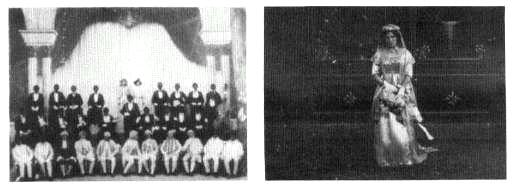The Lecture
The lecture, always an important strategy in the exhibitor's repertoire, was the focus of renewed interest by early 1908. In January Billboard reported: "Many moving picture houses are adding a lecturer to their theatre. The explanation of the pictures by an efficient talker adds much to their realism."[89] W. Stephen Bush, a former traveling exhibitor and a frequent contributor to Moving Picture World , considered the lecture "a creative aid to the moving picture entertainment." Bush, who often lectured at church functions, approached cinema as a traditionalist who wanted to instruct as well as entertain. He condemned the uneducated exhibitor who showed a Shakespearean play on film without a lecture and "bewildered his patrons, who might have been thrilled and delighted with a proper presentation of the work."[90] Bush prepared and offered to sell special lectures, with suggestions as to music and effects, for every feature turned out by the Edison licensees.[91] He was probably the anonymous reviewer who felt that Porter's The Devil "is a fine production and if given with a lecture yields little to the real play."[92] Likewise, Colonial Virginia (made in May 1907 and eventually released by Edison in November 1908) needed "to be presented with a lecture for the spectators to fully understand and appreciate the scenes that are presented."[93]
Bush argued that a nickelodeon's addition of a skilled lecturer would more than offset the additional salary costs by increasing patronage and turnover. "Why do so many people remain in the moving picture theater and look at the same picture two and even three times?" he asked. "Simply because they do not understand it the first time; and this is by no means in every case a reflection on their intelligence. Once it is made plain to them, their curiosity is gratified, they are pleased and go."[94] In an article entitled "The Value of a Lecture," Van C. Lee claimed surprise that "the managers are just awakening to the fact that a lecture adds much to the realism of a moving picture." Like Bush he asked his readers, "Of what interest is a picture at all if it is not understood?"[95]
Bush's and Lee's viewpoints were substantiated by considerable evidence. James H. Flattery, a humorist and elocutionist who had been in the Ed Harrigan Irish Comedian Company, lectured at the Novelty Theater on Third Avenue in New York City with great success, large crowds packing the theater each night.[96] The Casino Company, which owned a half dozen theaters, tried out a lecturer in its three Detroit houses and then added "talkers" in its three Toledo, Ohio, venues.[97] The lecture, however, encountered serious obstacles. A film fan in Augusta, Georgia, tried to convince local managers to add a lecture and found that they were reluctant to increase their expenses.[98] Some exhibitors lacked

Left: Spook Minstrels. Right: Vesta Victoria sings "Waiting at the Church."
access to plot synopses and often did not entirely follow the stories themselves. Furthermore, talented lecturers were difficult to find. General reliance on lectures was unlikely, given the rapid turnover of subject matter, the exhibitor's narrow profit margin, and the substantial number of films that were intelligible without such aid. In seeking to apply traditional strategies of screen presentation to this new form of mass exhibition, Bush and Lee failed to acknowledge the many obstacles that prohibited its broad application.